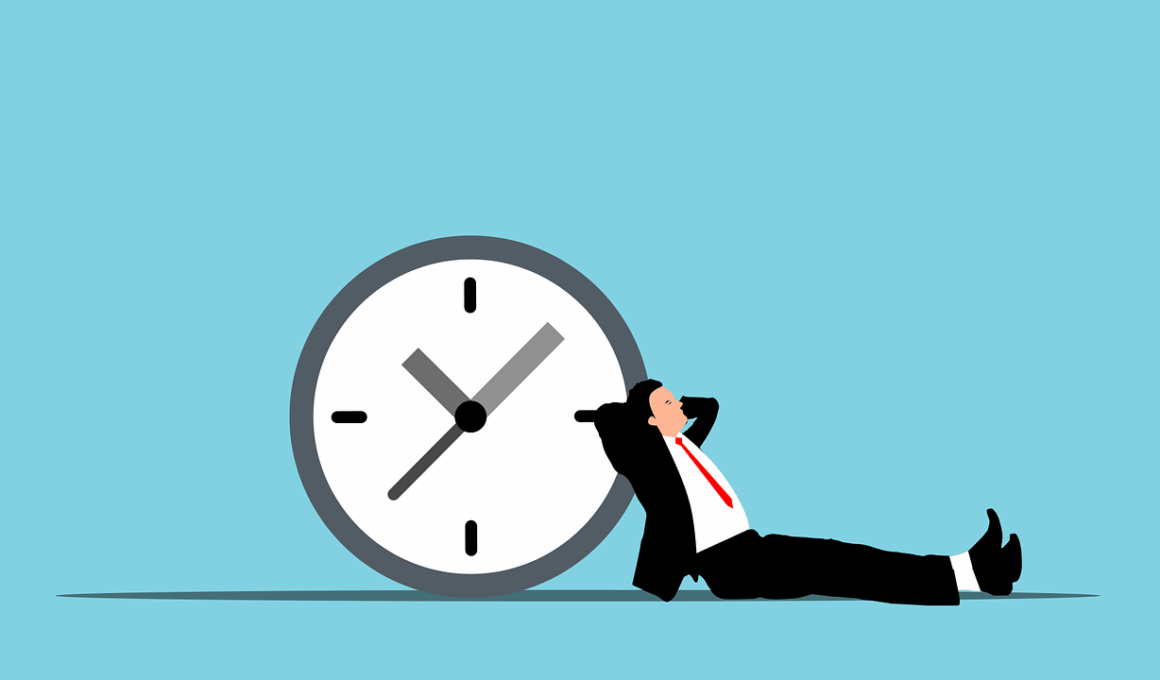Incorporating Rest Days into Your Beginner Workout Routine
When starting a new workout regimen as a beginner, it’s easy to get excited and want to train every day. However, incorporating rest days into your routine is just as vital as the workouts themselves. Rest days help in muscle recovery, prevent injury, and improve overall performance. Beginners should understand that the body requires time to adapt to new stresses from workouts, particularly when engaging in high-intensity activities. Overworking your muscles can lead to fatigue and serious injuries, which may derail your fitness journey. An effective strategy is to schedule rest days wisely, typically after a few consecutive workout days. Listening to your body is crucial; if you feel overly sore or fatigued, those are signs that your body needs a break. Notably, rest doesn’t imply complete inactivity; active recovery can involve light activities like walking or yoga. Ensuring adequate hydration and nutrition on rest days also plays a significant role in recovery. By prioritizing rest in your weekly fitness routine, you set the foundation for sustainable progress and healthier training habits that will benefit you long-term.
The Importance of Recovery in Fitness
Recovery is often overlooked in the beginner workout landscape. Many individuals mistakenly believe that continuous exercise leads to faster results, yet recovery is essential for preventing burnout. Taking scheduled rest days allows time for muscles to repair and strengthens them after rigorous workouts. This rebuilding phase is crucial since muscles sustain microtears during exercises, which need time to heal. Furthermore, consistent rest days can help reduce soreness and stiffness, thus making subsequent workouts more manageable and enjoyable. It’s beneficial to incorporate various types of rest days, including complete rest, where no strenuous activities are performed, and active recovery days that involve less intensive exercises or recreational activities. Beginners should aim for at least one to two rest days weekly, adjusting based on individual fitness levels and goals. Moreover, incorporating stretching, foam rolling, and hydration is vital during these times for optimizing recovery. Consult with fitness professionals if uncertain about creating a balanced routine. By recognizing the importance of recovery, beginners will build a solid foundation for a lifelong engagement in their fitness journey.
Setting up a workout schedule requires beginners to establish a routine that effectively balances workouts and rest days. One helpful approach is the 5-2 model, where you work out five days a week, followed by two days of rest. This method allows muscle group targeting throughout the week while facilitating recovery periods. Another tactic involves alternating workout intensity. For instance, you might follow a high-intensity workout day with a lower intensity day. Additionally, taking note of your energy levels can play a crucial role; planning more intense workouts on days you feel highly motivated and strong can make a significant difference in long-term adherence. Beginners may also benefit from maintaining flexibility in their plans to avoid feelings of restriction. This strategy can help keep motivation high, ensuring that taking a rest day doesn’t become a source of guilt or disappointment. Lastly, tracking progress and how your body feels throughout your fitness journey can be incredibly rewarding. Learn to appreciate how rest days contribute to your overall growth and progress in the fitness realm for lasting commitment.
Mixing Active and Passive Recovery
There’s value in diversifying your recovery methods as a beginner. Passive recovery involves complete rest from any physical activity, while active recovery consists of lighter engagements such as stretching, walking, or yoga. Both forms are essential; incorporate them based on how your body responds during intense workout periods. Passive recovery days are crucial when you feel muscle fatigue or soreness after rigorous exercise sessions. Listening to your body is key in determining which type of recovery you need on specific days. On the other hand, active recovery can help increase blood flow and relieve muscle tightness without putting additional strain on your body. This approach is especially beneficial on off days, where light activities maintain blood circulation. Adding fun, low-impact exercises can keep your spirits high and promote a healthy, holistic recovery process. Recovery is more than merely taking a break; it’s valuable in preparing your body for future workouts, making strides to avoid injuries, and fostering a consistent fitness habit. In every aspect, listen, feel, and respond accordingly to your body’s needs.
Nutrition plays a vital role in supporting recovery on rest days for beginners. Consuming a balanced diet rich in protein, healthy fats, and carbohydrates is essential for replenishing your body’s energy stores. Optimal nutrition aids muscle repair, combats inflammation, and sets the stage for the next workout. Post-workout nutrition often emphasizes protein, but rest days also require the same attention to dietary choices. Focus on nutrient-dense whole foods rather than empty calories; examples include lean meats, whole grains, fruits, and vegetables. Pairing complex carbohydrates with proteins optimizes recovery and supports muscle growth. Staying adequately hydrated on rest days is equally as critical to facilitate recovery and replenish fluids lost during workouts. Additionally, consider incorporating anti-inflammatory foods to help minimize muscle soreness. Foods like berries, fatty fish, and green leafy vegetables can work wonders. Don’t neglect the importance of proper meals and snacks throughout the day; making meals enjoyable while tracking your nutrition can improve adherence to fitness goals. By prioritizing nutrition on recovery days, you’ll fortify your commitment to achieving an active lifestyle.
Listening to Your Body
Beginners must understand the significance of tuning into their body’s cues as part of their fitness strategy. Pushing through pain and fatigue may lead to injuries or setbacks in your fitness journey. Rather than adhering to a strict schedule, it’s crucial to listen to your body’s needs. If you find yourself feeling excessively fatigued or experiencing persistent soreness, it’s a signal to adjust your routine accordingly. Incorporating light stretching and mobility work on rest days can help release tension and encourage better recovery. Regularly assessing how you feel can significantly enhance your workout experiences in terms of performance and motivation. Not everything goes according to plan, and plans must adapt as fitness levels change. Journaling or tracking how your body responds to different workouts can help identify patterns of fatigue and recovery needs over time. Recognizing your limits is equally key to building a sustainable workout routine. Remember that everyone’s body is uniquely wired, and your response to workouts may differ from others. Let this exploration of self-awareness enhance your fitness journey and keep you engaged in pursuing a balanced workout routine.
In conclusion, incorporating rest days into your beginner workout routine is an invaluable strategy for promoting sustainable progress. It’s crucial to recognize that fitness is not just about exertion; recovery plays an equally important role in building strength, endurance, and overall well-being. As a beginner, focusing on nurturing your body through scheduled rest can lead to increased motivation, improved performance, and significantly reduced risk of injury. Whether utilizing passive or active recovery, you will establish a more balanced routine that helps build a solid foundation for a lifelong commitment to fitness. Don’t forget that rest days involve much more than just doing nothing; they are an opportunity for mindful engagement with your body’s needs through proper nutrition, hydration, and light activities. By emphasizing the importance of rest, you will empower yourself to enjoy your fitness journey more. Remember, consistency is key, and rest days are integral in achieving long-lasting results. As you advance in your fitness journey, adapting your routine will become second nature. Embrace rest, enjoy the process, and thrive in your commitment to health and fitness!
The Importance of Recovery in Fitness
Recovery is often overlooked in the beginner workout landscape. Many individuals mistakenly believe that continuous exercise leads to faster results, yet recovery is essential for preventing burnout. Taking scheduled rest days allows time for muscles to repair and strengthens them after rigorous workouts. This rebuilding phase is crucial since muscles sustain microtears during exercises, which need time to heal. Furthermore, consistent rest days can help reduce soreness and stiffness, thus making subsequent workouts more manageable and enjoyable. It’s beneficial to incorporate various types of rest days, including complete rest, where no strenuous activities are performed, and active recovery days that involve less intensive exercises or recreational activities. Beginners should aim for at least one to two rest days weekly, adjusting based on individual fitness levels and goals. Moreover, incorporating stretching, foam rolling, and hydration is vital during these times for optimizing recovery. Consult with fitness professionals if uncertain about creating a balanced routine. By recognizing the importance of recovery, beginners will build a solid foundation for a lifelong engagement in their fitness journey.


